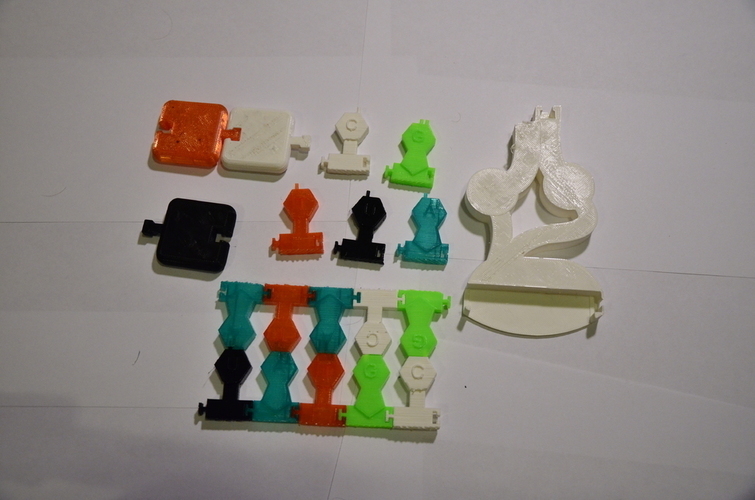
DNA/RNA Building Set/Transcription and Translation Model
pinshape
This learning set is designed to empower students to grasp DNA and RNA by engaging with the blocks, while also serving as a manipulative tool to model processes that involve DNA (described below). The set is engineered to be accessible for both visually impaired and sighted students to learn about DNA, replication, and transcription through hands-on exploration. Each nucleotide block contains a raised letter symbol and shape of its corresponding base (either purine or pyrimidine), allowing students to feel and see the approximate shapes of these molecules. The posts and holes at the top of each piece represent the number of hydrogen bond donors (the posts) and acceptors (holes) that each base has, which determine how bases pair in a DNA molecule. Nucleotide blocks link together at the bottom to form the DNA or RNA backbone, while their tops connect together to show hydrogen bonding with complementary DNA or RNA strands. Blocks are designed so only correct pairs can connect (A with T, A with U, G with C), enabling students to learn about DNA structure and base pairing through hands-on experimentation without prior instruction. All pieces can only be connected in the correct orientation, allowing students to determine by feel whether two pieces should connect. The tRNA models are included to demonstrate the processes of transcription and translation. After creating a model of double-stranded DNA, the strands can be split, and a complementary mRNA strand built (substituting uracil for thymine). This mRNA strand is then removed. The anticodon on the tRNA models can be customized by inserting a sequence of three nucleotide blocks that pair with the sequence on the mRNA strand. Each anticodon matches a different amino acid block, which can be linked to the top of the tRNA model. The tRNA models can then be bound to the mRNA strand, and amino acid blocks linked to form a protein. This set can also be used to teach how DNA mutations such as deletions, insertions, and frame-shifts affect the final amino acid sequence for the protein coded by the DNA. A blocking group is included to demonstrate how DNA sequencing is done. Print Settings Printer: Da Vinci Jr. Rafts: Yes Supports: Yes Resolution: .2mm Infill: 5-10% Notes: Rafts and supports are only needed for printing the nucleic acid blocks. Standards NGSS CCSS Overview and Background Objectives: Students will be able to describe how nucleotides hydrogen bond in specific pairs. Students will be able to describe what happens to DNA structure when a base pair is mis-matched. Students will be able to build complementary DNA and mRNA strands to a pre-built template DNA strand. Students will be able to describe the processes of transcription and translation. Students will be able to describe how proteins are made from DNA. Students will be able to describe the different roles RNA can play (mRNA, tRNA, rRNA). Students will be able to describe the difference between purines and pyrimidines. Students will be able to describe the different ways that DNA can mutate (deletions, insertions, etc.) and how these affect the final protein product. Students will be able to recognize start and stop codons as well as describe how each tRNA has a specific anticodon that codes for a particular amino acid. Lesson Plan and Activity: The following is a description of how transcription and translation can be modeled using this set. As described in the summary, this set can be used to model a wide variety of concepts for DNA and RNA. Create a template DNA strand from the blocks (you can choose the sequence of DNA to reflect a specific sequence of amino acids as well as a stop codon if you want to focus on protein structure or the effects of mutations on the final protein). Students must use the nucleotide blocks to create a complementary mRNA strand that can leave the nucleus and go to the ribosome. Either set up the needed tRNA molecules with the correct anti-codons and amino acids attached or have students create these. Demonstrate how the first tRNA binds to the mRNA while it is in the ribosome, moves over, then the next one binds. The amino acids then transfer to the new tRNA and the old one leaves. This process repeats, illustrating how different DNA sequences lead to different amino acid sequences. Additional Lessons: -mRNA processing steps can also be integrated into this lesson -The effects of mutations on transcription and translation, such as deletions and frame shifts, can be illustrated with the model. Materials Needed No materials besides the model kit are needed.
With this file you will be able to print DNA/RNA Building Set/Transcription and Translation Model with your 3D printer. Click on the button and save the file on your computer to work, edit or customize your design. You can also find more 3D designs for printers on DNA/RNA Building Set/Transcription and Translation Model.
